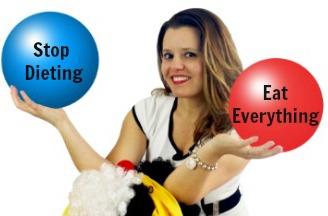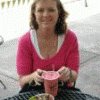Yes you can drink and eat at the same meal time

There is no concern in flushing the food through the gastric band when the area above the band is empty.
Recent research has provided a better understanding of the how the gastric band works, conducted by CORE in Melbourne. We now understand that food only remains in the area above the gastric band for approximately 1 minute, it is then pushed through the gastric band via the oesophageal pressure. This takes about 3 to 6 peristaltic motions.
You can eat and drink at the same time; however it is essential you allow sufficient time between swallows to ensure the area above the gastric band is completely empty, before you consume a sip of your drink.
However, be careful to not drink liquids with your meal to assist the movement of food through the gastric band, this is cheating. Focus on tasting and enjoying the flavours and textures which will enable your saliva to soften the food and make it easier to grind the food into a past prior to swallowing.
Many people feed back to me that they often do not wait long enough between mouthfuls and take a sip too early and get into trouble. So you may wish to consider an alternative option to not drink and eat during your meal, but rather eat your meal and begin drinking again once you feel comfortable.
Choose either option, or blend them both when it suits you as summarized below:
A little personal experience when it comes to "research"...
I have dealt with years of conflicting research way before I considered Lap-Band. I have Multiple Sclerosis, and just like we're seeing here, conflicting "facts" seem to run amok no matter what the topic is at hand. I also notice that in this day and age where anyone can post an article and deem it factual without any repercussions or accountability, all it takes is a little Google-foo skills and you can back just about any opinion you want with supposed "facts".
Two things I have learned over the years- don't believe everything you read and don't believe everything presented as facts necessarily is.
Furthermore, just because someone claims to have done a clinical trial or comparative study doesn't mean it's reliable. Did they have control groups? Did they have 3 participants or 300? Was this overseen by medical professionals who specialize in the field in question, and if so, who were the experts? This all needs to be taken into consideration.
As for this article, I'm still waiting for this information to be provided to validate it, knowing even then it doesn't necessarily mean it has accurate results. Now, if someone could duplicate their findings with proven scientific methods? Repeatedly? Then, and only then, I'd take notice.
Although I disagree with Helen's suggestion that it's OK to drink while eating, I want to mention something that isn't part of her article. Usually each magazine article is followed by an author info blurb, in which the author's credentials and/or position are described. But because of site updates that are now underway, this info isn't being included and as a result, members reading Helen's article may be unaware that she is a dietitian, presumably qualified to talk about bariatric nutrition, and she's located in Australia, where the adjustable gastric band has been in use a lot longer than in the USA.
These could be the study in question:
http://www.ncbi.nlm....pubmed/20835896
http://www.ncbi.nlm....pubmed/21912383
http://www.ncbi.nlm....pubmed/21136303
The conclusion of the 3rd:
CONCLUSIONS:
Weight loss, satiety, and early satiation following LAGB were associated with briefly delayed bolus transit into the infraband stomach. Retention of the semisolid meal above the LAGB was not observed. This is further evidence that suggests satiety develops following LAGB without physical restriction of meal size.
What was quite interesting was that about a year ago I contacted Allergan with this exact query. I asked how long it took for the food to pass through and why if it was passing through so quickly one could not drink soon after eating.
They actually phoned me which I was quite shocked about as they are in the USA and I am in Aus. They could not give me an answer to the question. They did not seem to believe that the food passed through quickly and said that it took a while but could not put a time to that. Quite strange when the manufacturer does not know how it's product works.
Yes Helen is a highly regarded dietician and works with one of our most highly regarded bariatric surgeons.
However for me the info still does not give all the answers.
Cocoa I imagine that with the test they only watched a few bites and presumably because it was test conditions you were not eating the way you would do normally. Even if unintentionally you were probably more aware of how you were chewing. I think that to come up with a definitive answer they would need to test a large number of people and watch as they ate an entire meal. The difficulty would be to get people to relax and eat the way that they normally do when at home.
WOW, what great discussions, thanks so much guys. When ever evolving research challenges our belief system, it will always stir the pot. Let me address all of your concerns.
(1) I have a Bachelor of Science degree and a Masters in Nutrition and Dietetics and an APD in Australia. I have worked with lap band patients since year 2000 and have counselled over 3000 individuals. I currently work with the Centre of Bariatric Surgery which is run by Professor Paul O'Brien, the founder of the lap band in Australia. I also work closely with Centre for Obesity Research and Education (CORE). I have been involved in research assessing the best nutritional make up of the diet and the ideal frequency of meals to lose weight with the lap band in association with CORE. As Cocoabean has linked above the new research regarding how the food passes through the lap band has been determined by Mr Paul Burton via CORE. I hope this helps show people I understand and practically apply the most recent research in my practice and recommendations. Thank you Jean for the clarification on why my Bio was not uploaded, much appreciated. More details can be seen at http://www.globalgastricbandsolutions.com.au/helen-bauzon/leading-bariatric-dietitian/
(2) The research surrounding the movement of the food bolus through the lap band was conducted on a texture of porridge with a well adjusted and well functioning lap band. So there would be no indication of a pouch or oesophageal dilatation. Hence the bolus of food would ideally be pushed through within the 1-2 minutes. If the area of above the lap band is empty completely of food, then there is no harm in taking a sip of Water for example. I have attached three articles by Dr Paul Burton which has some great graphics to view. I was unable to attach them here so you can view them at http://www.globalgastricbandsolutions.com.au/lap-band-diet-drinking-and-eating-with-your-food/
(3) If the food passes through that quickly if pain is experienced, then some possible explanations could be:
- A too big of a mouthful of food was consumed
- Not chewed adequately
- Did not wait long enough between swallows
- Possibly tried to eat a food that is generally difficult to consume with the lap band
- Had a previous blockage and swelling /irritation has resulted
(4) These solid research findings by CORE have been implemented into a video presentation produced by Professor Paul O'Brien and is well circulated in Australia. I am aware that more footage is being prepared and once available I will inform everyone.
(5) These recommendations are far from reckless and have research to support them. My passion and what I am known for is getting lap band patients to eat normal solid food pain free, but making them understand how the lap band really works. The lap band does not create a small stomach but rather a 'funnel' concept. The role of the band is to slow us down and make us feel more satisfied on a smaller portions of food by placing pressure on the receptor sites via the lap band itself and pressure from the food.
(6) Please do not confuse this discussion with the impact of consuming liquid foods compared to solid foods and the effect on satiety. These are two different topics.
(7) It is well respected that everyone with a lap band belongs to a particular weight loss surgery clinic with their own views and opinions. It is for this reason that I ended the article with two options for you to make a personal decision that would suit you best, highlighted below.
Choose either option, or blend them both when it suits you as summarized below:
Cocoa I imagine that with the test they only watched a few bites and presumably because it was test conditions you were not eating the way you would do normally. Even if unintentionally you were probably more aware of how you were chewing. I think that to come up with a definitive answer they would need to test a large number of people and watch as they ate an entire meal. The difficulty would be to get people to relax and eat the way that they normally do when at home.
Elcee, you are right, I only ate a few bites of a sandwich. It was for the purpose of checking my restriction level and for reflux. And you are again correct in that I was very aware of my chewing. But after my experience, my personal belief is that food passes through the band fairly rapidly. With each bite I took, it went through fairly quickly. But then again, I don't normally take a bite, watch it on TV for 30 seconds to a minute then take another bite. But they were normal sized bites, if covered with barium.
I get to repeat it again this week..yum.
Throughout medical science we see treatments that are effective for some unexplained reason. We see off-label use of medications for conditions other than for which they were developed. Apparently Allergen doesn't even know.
I dunno. I think there is just way more to be learned about the mechanism of how the band works, myself.
I dunno. I think there is just way more to be learned about the mechanism of how the band works, myself.
I agree, I think a lot of the theories are just that at the moment, theories. A bit like the hygiene hypothesis and allergies - although the theory has been around for ages it has still not been fully proven which is why it is still a hypothesis.
Thanks Helen for giving us more clarification, unfortunately the questions I asked in my first response were still not answered.
I think the funnel concept is correct but what we are not looking at is what happens to the last food that goes into the funnel. Yes the initial food that gets put in there goes through quite quickly but what goes in later goes through slower - "like sands through an hourglass".
Interesting graphic in 1 of the links that Helen posted. It shows the modern placement of the band which is in a completely different position to where most of us believe our bands to be. I wonder how many of us have bands that are in this position and how many bands that were placed in the position shown in the other pic and what effect it has on how successful we are with our weight loss.
If only I could understand all the "study speak" of the study! Page 3 does have some very interesting information on the pouch filling up. It also speaks to us feeling the reflux from peristalsis if it hasn't cleared on the first trip down. interesting. And exactly what I experienced. They also observed some stuck episodes..cool!
I think we will be seeing more studies of this type come out. If nothing more in an effort to understand truly how bands work and to see if they can be made better.
I do not drink while actually eating but I do drink right before a meal and about 15 tp 20 minutes post meal. If I drink with a meal it is no different than before I was banded the Fluid feels me up. If you read the literature the food does not stay in the pouch but for a few minutes. There will continue to be new articles as the band is in use longer, what I am more interested in is the long term effects of lap band. How are people responding 10-12 years down the road, are the still successful, do they still get fills or did they modify there behavior to the point of not needing the band. Those are the type of articles that I am more interested in not drinking while I eat.
WOW, what great discussions, thanks so much guys. When ever evolving research challenges our belief system, it will always stir the pot. Let me address all of your concerns.
(1) I have a Bachelor of Science degree and a Masters in Nutrition and Dietetics and an APD in Australia. I have worked with lap band patients since year 2000 and have counselled over 3000 individuals. I currently work with the Centre of Bariatric Surgery which is run by Professor Paul O'Brien, the founder of the lap band in Australia. I also work closely with Centre for Obesity Research and Education (CORE). I have been involved in research assessing the best nutritional make up of the diet and the ideal frequency of meals to lose weight with the lap band in association with CORE. As Cocoabean has linked above the new research regarding how the food passes through the lap band has been determined by Mr Paul Burton via CORE. I hope this helps show people I understand and practically apply the most recent research in my practice and recommendations. Thank you Jean for the clarification on why my Bio was not uploaded, much appreciated. More details can be seen at http://www.globalgas...tric-dietitian/
(2) The research surrounding the movement of the food bolus through the lap band was conducted on a texture of porridge with a well adjusted and well functioning lap band. So there would be no indication of a pouch or oesophageal dilatation. Hence the bolus of food would ideally be pushed through within the 1-2 minutes. If the area of above the lap band is empty completely of food, then there is no harm in taking a sip of Water for example. I have attached three articles by Dr Paul Burton which has some great graphics to view. I was unable to attach them here so you can view them at http://www.globalgas...with-your-food/
(3) If the food passes through that quickly if pain is experienced, then some possible explanations could be:
- A too big of a mouthful of food was consumed
- Not chewed adequately
- Did not wait long enough between swallows
- Possibly tried to eat a food that is generally difficult to consume with the lap band
- Had a previous blockage and swelling /irritation has resulted
(4) These solid research findings by CORE have been implemented into a video presentation produced by Professor Paul O'Brien and is well circulated in Australia. I am aware that more footage is being prepared and once available I will inform everyone.
(5) These recommendations are far from reckless and have research to support them. My passion and what I am known for is getting lap band patients to eat normal solid food pain free, but making them understand how the lap band really works. The lap band does not create a small stomach but rather a 'funnel' concept. The role of the band is to slow us down and make us feel more satisfied on a smaller portions of food by placing pressure on the receptor sites via the lap band itself and pressure from the food.
(6) Please do not confuse this discussion with the impact of consuming liquid foods compared to solid foods and the effect on satiety. These are two different topics.
(7) It is well respected that everyone with a lap band belongs to a particular weight loss surgery clinic with their own views and opinions. It is for this reason that I ended the article with two options for you to make a personal decision that would suit you best, highlighted below.
Choose either option, or blend them both when it suits you as summarized below:
1. Wait enough time between mouthfuls before consuming a sip of your drink2. Consume a glass of Water before the meal, eat your meal then begin drinking again once you feel comfortable.I wish everyone luck with their own drinking and eating. Lets discuss further as required to clarify.
How about advising the readers that they should consult with their individual physicians prior to modifying their practices with drinking fluids?
Anything short of that, in my view, has the very real potential to compromise the weight loss success for the patient.
From what I read, your statements lack the citations and depth of research necessary to validate the evidence that it is permissible to eat and drink at the same time, whether it is waiting for a minute after a bite of food or not...
"5) These recommendations are far from reckless and have research to support them."
If your above mentioned research does in fact exist, you should have included it in your article, so that we all could learn more about your perspective and why you wrote this article.
Also, it seems that your highest level of education is a master's degree, not an MD. As such, I strongly believe, as a dietitian your writing in this article goes well beyond the scope of your professional practice, though you do cite your professional affiliations.
I also hold a master's degree, and have remained accurately aware of the scope of my practice, and respected the additional training and credentials of the many doctors I worked along side through the years I was in active private practice. It does seem to me that spirit this article is to challenge the professional opinion of many physicians, who I believe are far better qualified to render a professional opinion about drinking while eating a meal.
The article you wrote should have advised the readers that they needed to consult with their physicians before changing their use of fluids. Anything short of that is what I would term a violation of professional ethics.
Hi Guys,
Lets just keep it simple. You may like to try an exercise. Have a simple meal such as a dry biscuit and some low fat cheese or tinned tuna on top. Take 1 tsp portion, chew to a paste and wait one to two minutes and then take a sip of Water. If the Water goes straight through, the upper part of 'funnel' concept is empty. It supports the research being conducted by CORE. Also keep in mind if someone has a pouch and oesophageal dilation, it's likely to take longer for the food to pass through. This is a whole other discussion.
Once an individual loses their desired weight, removing the band or removing all saline from the system, will result in the hunger returning most likely. I see this in my practice when Fluid is removed short term for a variety of reasons, weight gain is common.
In theory, each mouthful will take that 1-2 minutes to pass through the band all variables controlled. So whether it is the first or last mouthful it should be the same.
I'm glad we are having a great conversation around this topic, because once the mechanics of the band is understood, from my experience more people will use the band correctly and minimize regurgitation and maximize their weight loss and well being.
As a dietician specialising in the management of Lap Band patients I feel it is important to discuss the management holistically. Just like in my general practice, I explain what coeliac or diabetes is as a disease state prior to explaining the required dietary changes. Point taken, research articles will be included with the original post from here onwards. I feel very fortunate to be working so closely with the team at CBS and CORE to be made aware of the most recent research as it occurs.
It is all about working together. Happy chewing.
I can only go by my own experience. No, I can not drink while eating and no thanks on the dry biscuit and then drink. That would cause me discomfort.












bigenuff 302
Posted
I have always assumed I didn't have to wait 30 min to drink.so my compromise between what my Dr daid and what i think has been to wait 10-15 min until I thought the food passed then start drinking slowly checking for signals if it was ok.I've done that since I started solids with no problem except my one " stuck incident" I tried to drink to move the food.
Share this comment
Link to comment
Share on other sites